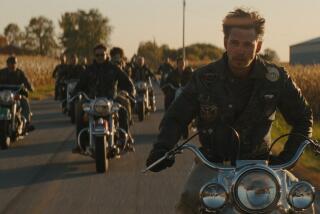‘Losers’ who really made their mark
YOU MAY not know their names, but you likely recognize their work. Emerging from the Alleged Gallery in New York, the artists featured in the new documentary “Beautiful Losers” created imagery that has gone from being off-the-map to mainstream and a vital part of contemporary visual culture -- Andre the Giant posters by Shepard Fairey, the graphic design and commercial work of Mike Mills and Geoff McFetridge, the sophisticated, knowing amateurism of Chris Johanson, Margaret Kilgallen and Barry McGee.
Compiled from archival footage and contemporary interviews with many of the artists involved, the film is co-directed by Aaron Rose, who started the Alleged Gallery and co-curated the long-traveling exhibition that showcases the work displayed there. Other artists featured in the film include Jo Jackson, Ed Templeton and Stephen Powers, and the milieu of the gallery also included a young Harmony Korine -- an excerpt from an early film by Korine is included in “Beautiful Losers.”
The gallery ran from 1992 to 2002, so it may seem strange to already be looking back at a period that occurred not so long ago. Yet in the time period portrayed in “Beautiful Losers” information traveled much differently, and it seems very much of another era.
“Sometimes it takes 20 years for something to feel important,” Rose said of the decision to make a documentary of this particular time and place. “But still it seemed, even to me, a little funny to be like ‘back in the day, ’96.’ It just seemed like it was yesterday.
“But it was important to me this film got made when everyone was still kind of youngish. I think the film wouldn’t be as inspiring if it was made 10 or 20 years from now. Now the artists are not that far removed from the archival footage, so it’s easier to draw connections.”
“A decade is a decade I suppose,” said Templeton, via e-mail. “1994 does seem like another life at this point.”
The title “Beautiful Losers” was chosen for the traveling exhibition when Rose scanned a shelf of books and noticed the 1966 novel by Leonard Cohen of that name.
The artists of the Alleged Gallery had strong connections to the subcultures of skateboarding, graffiti and punk/indie rock, such that the film might just as easily be called “Revenge of the Nerds.”
“I always thought of the gallery more like a record label than something in the art world,” said Rose. “It was an attitude, it was a punk gallery. I wasn’t thinking about auctions or art collections. There were no collectors. The first time we sold a drawing for $20 I was just totally blown away that somebody bought it.”
As the artists of the Alleged Gallery made inroads into the conventional art world they also frequently moved into the worlds of commercial art. Record covers, skateboards, T-shirts and sticker design had long been a part of their world, but soon Mills was directing TV spots for the Gap and Volkswagen, while McFetridge designed the main title sequence for Sofia Coppola’s “The Virgin Suicides” and designed artwork for a campaign for Pepsi. Also, artists were being poached by other galleries.
Rose and his artists were navigating a terrain that could be seen as in opposition to the DIY ethos from which they emerged. With commercial success came claims of “selling out,” a watchword bandied about frequently during the ‘90s.
“I think corporations have changed since ‘selling out’ was such an issue,” said Rose. “Corporations have learned over the years, how to treat these alternative cultures.”
Tied in with Nike
The relationship to corporate culture extends to the manner in which “Beautiful Losers” is coming to theaters. Nike Sportswear has partnered with the film’s distributor Sidetrack Films in underwriting the theatrical release. As well, Nike will sponsor a series of community and youth-oriented creative workshops tied to the film.
Words like “inspiring” and “beautiful” get tossed around quite a bit in “Beautiful Losers.” More than an instance of instant nostalgia, the film is a low-key celebration of people and community, what can happen when like-minded individuals really get it together.
“I made it for kids,” said Rose, “to teach the DIY spirit, to show the power of that not just in your career but in your success in life.”
Rose takes particular satisfaction, however, in a rather specific adult-oriented response.
“I’ve already heard of two people quitting their jobs after seeing it,” he said.
More to Read
The biggest entertainment stories
Get our big stories about Hollywood, film, television, music, arts, culture and more right in your inbox as soon as they publish.
You may occasionally receive promotional content from the Los Angeles Times.











